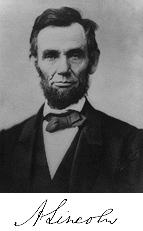 Fondly do we hope -- fervently do we pray -- that this mighty scourge of war may speedily pass away. Yet, if God wills that it continue, until all the wealth piled by the bond-man's [slave's] two hundred and fifty years of unrequited toil shall be sunk, and until every drop of blood drawn with the lash, shall be paid by another drawn with the sword, as was said three thousand years ago, so still it must be said "the judgements of the Lord, are true and righteous altogether."
Fondly do we hope -- fervently do we pray -- that this mighty scourge of war may speedily pass away. Yet, if God wills that it continue, until all the wealth piled by the bond-man's [slave's] two hundred and fifty years of unrequited toil shall be sunk, and until every drop of blood drawn with the lash, shall be paid by another drawn with the sword, as was said three thousand years ago, so still it must be said "the judgements of the Lord, are true and righteous altogether."
-- Abraham Lincoln (March 4, 1865 at his second Inauguration)